Rajasthan is one of the most culturally rich destinations in India. Time seems to stand still in this land of deserts and palaces. A melting pot of tr
Rajasthan is one of the most culturally rich destinations in India. Time seems to stand still in this land of deserts and palaces. A melting pot of traditions and civilisations, Rajasthan has managed to attract hordes of tourists from across the globe. The well-preserved massive forts, iconic heritage buildings of importance, the delicious food of the royals and of course its traditional dances. The folk dances of Rajasthan are colourful, vibrant and elegant. Every dance is performed with immense grace and is an artfully powerful way of storytelling. One can get a clear picture of the rich melting pot of heritage that this land of the royals is home to. Here is everything you need to know about the folk dances of Rajasthan:
List of the 11 Traditional Folk Dance of Rajasthan
1. Ghoomar Dance
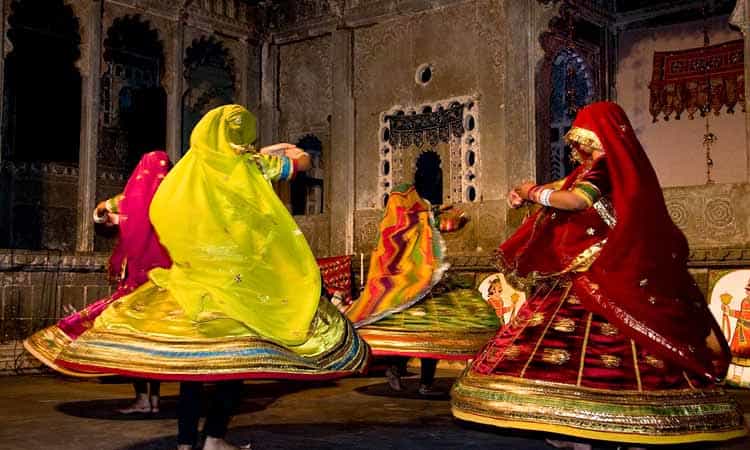
What started off as a spiritual, devotional dance dedicated to goddess Saraswati by the Bhil Tribe, Ghoomar was quickly embraced by other Rajasthani communities as well. The dance is mainly performed by women draped in colourful and glimmering traditional veiled Ghagra. Men are not allowed to witness this performance. The word Ghomna describes the twirling motion of the girls while performing the dance. As per traditions, newly married women are expected to perform the Ghoomar dance while she is being welcomed by her in-laws to her new marital home. Other special occasions like festivals, weddings and religious events remain incomplete without a Ghoomar dance performance.
2. Kalbeliya Dance
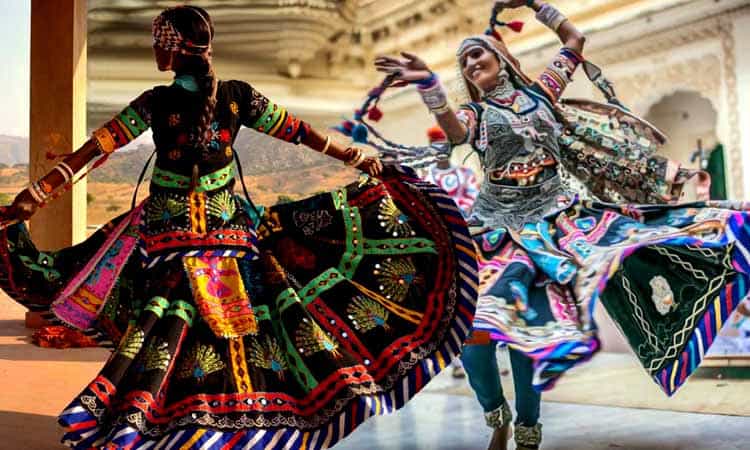
Also known as sapera or the snake charmer dance, the Kalbeliya Dance performance is done by the tribal people of the Kalbeliya community. This tribal Rajasthani community are the snake charming tribe who are primarily found in the Thar Desert region and the dance is an integral part of their culture. The dance is performed by both men and women to celebrate and mark special occasions. Their songs and dances mark their true identity as they represent the creative adaptation of this community. The main dancers are the women folk who whirl around in their flowing skirts replicating a snake-like movement. The male participants partake in the dance in the form of musicians and play local instruments like Pungi, Been, Dafli, Morchang, Khanjari etc.
3. Bhavai Dance
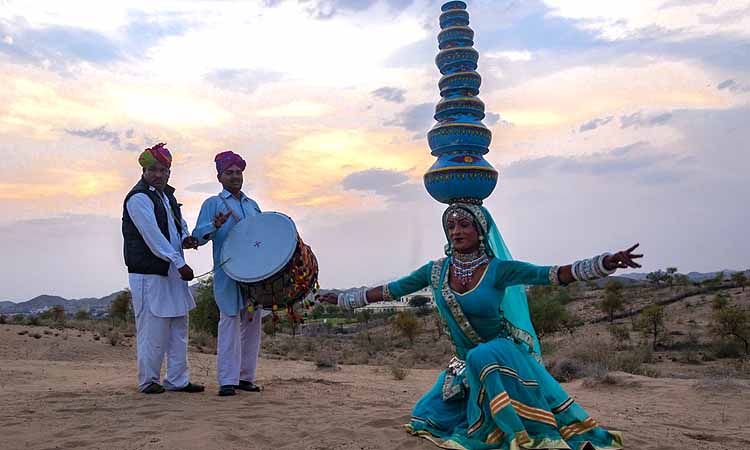
You may have seen pictures or videos on social media platforms, of local Rajasthani or Gujarati women balancing several pots set on top of each other on their heads. This genre of folk dance of Rajasthan is incredibly famous throughout the state. Performed by men as well as women, the performers balance earth pots or metal pitchers as they dance gracefully and nimbly while swaying and pirouetting. The main feature of this dance is when the dancer balances themselves on top of glass bottles or at the edge of a sword. The dance form involves veiled women balancing and swaying to the tunes with over 22 different pitchers balanced on top of their heads.
4. Kachhi Ghodi Dance
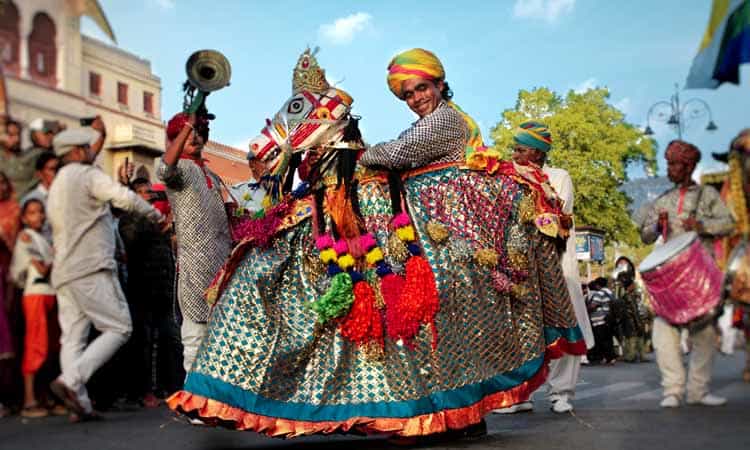
Originating from the bandit regions of Shekhawati and generally performed specifically for the entertainment of the bride groom’s party, Kachhi Ghodi Dance is not only famous in Rajasthan but in Gujarat as well. The dance is very entertaining to watch where the men traditionally wear dummy horses along with elaborate costumes like large red turbans and traditional dhoti and embellished Kurtas. The dancers groove in rhythmic unison to the sound of drums and fifes. They use props such as naked swords and sway them around to the beats of the music. The singer tells the audience about the exploits of the Bavaria bandits through its lyrics.
5. Gair Dance
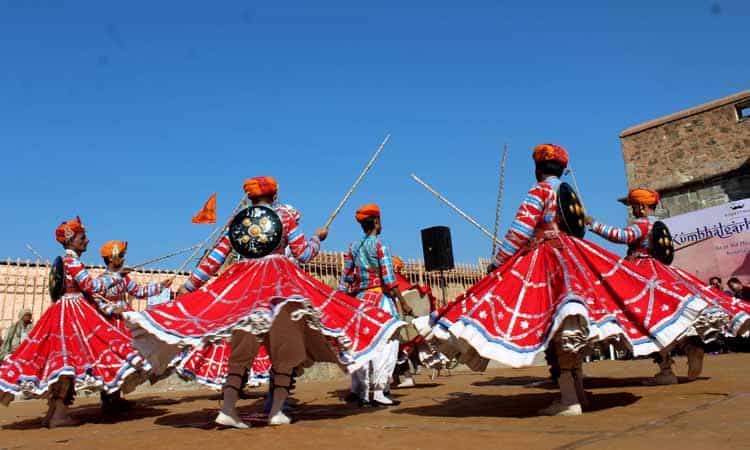
Performed by the famous Bhil community of Rajasthan, this famous folk dance is also known as Gair Ghalna, Gair Ghumna, Gair Khelna and Gair Nachna. The song is so popular that it has been embraced by other tribes and communities of Rajasthan. The dance has adapted itself according to different regions and many variations of the dance can be seen throughout the state. Performed by men as well as women in large circles with sticks in their hands. During the performance the men wear long, pleated tunics that open up into full length skirts. The women don their preference of a traditional dress while continuously, peacefully and gracefully moving together in circles. The dance involves following an intricate pattern of steps with half swirls along with the backdrop of traditional music.
6. Chari Dance
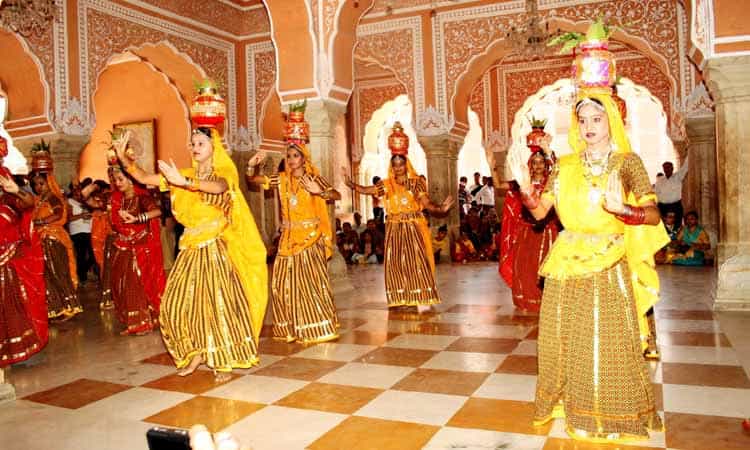
Chari is a women folk dance of Rajasthan that draws its inspiration from the dances of Ajmer and Kishangarh. Extremely prominent among the people of Gujjar and Saini community the dance is performed during special occasions like marriage ceremonies or during the birth of a child etc. the performances involve colorfully dressed women holding earthenware in their hands with brass pots or Chari on their heads. These Chari are often lit with diyas or fire containing cotton seeds immersed in oil. It is a rather stunning sight to behold as the dancers sway in graceful motion with deep knee swirls while the pots on their heads are ablaze.
7. Kathputli Dance
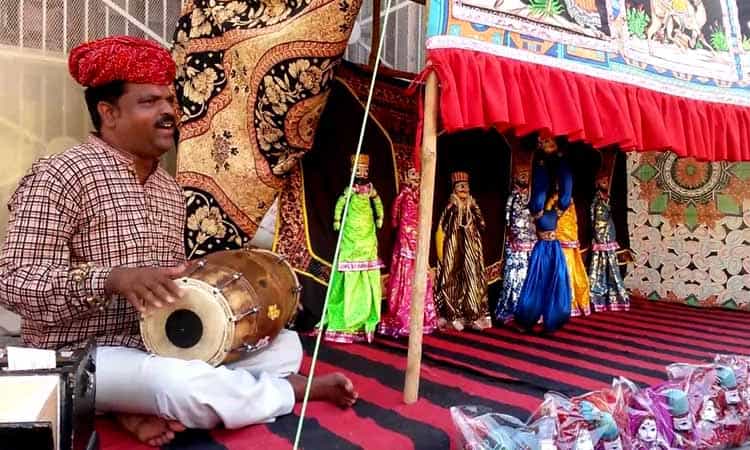
Rajasthan is extremely famous for its traditional puppet-playing art form that has been preserved through the ages. These puppets are known as Kathputli in the local language where the person handling these puppets or the puppeteer uses these puppets for ballad recitals and to tell stories. These stories range from love ballads to tales of romance. During the olden times, puppeteers used to travel from one village to another entertaining people by doing these performances. Different Kathputli styles are utilized for the show like string puppets, shadow puppets, glove puppets, etc. these Kathputli dances hold a very important place in the life and traditions of the Rajasthani folks as they tell the story of legends and mythologies that is not only entertaining but also incredibly knowledgeable and creates awareness.
8. Chakri Dance
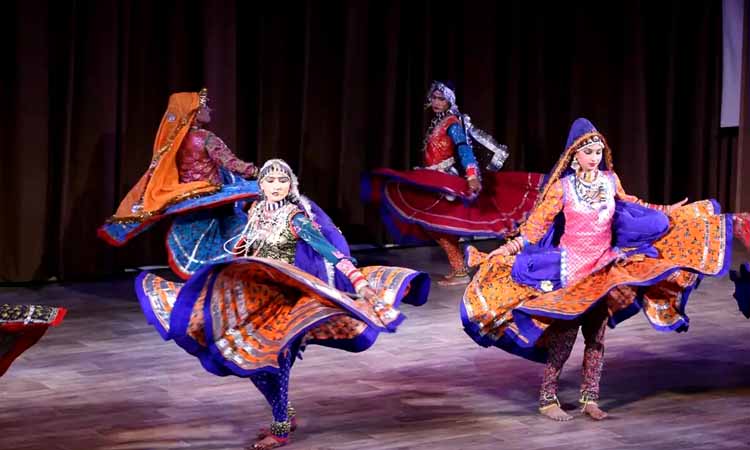
Chakri is a term derived from the Hindi word meaning circle. This dance is one of the most famous types of folk dances in Rajasthan. The name of the dance is inspired by the main movement of the dance that involves back and forth spinning movements in a fast-paced manner that can have a hypnotic effect on the audience viewing this dance. Being a graceful type of dance, it is mostly seen being performed during important and auspicious occasions like marriage ceremonies and various other festivals in Rajasthan. The roots of the dance are traced back to the women of the Kanjar tribe residing in the Baran and Kota district which soon turned from an entertaining activity to a source of livelihood for them. Technically supposed to be a solo performance, nowadays, large groups of people are hired to do the same performance.
9. Fire Dance
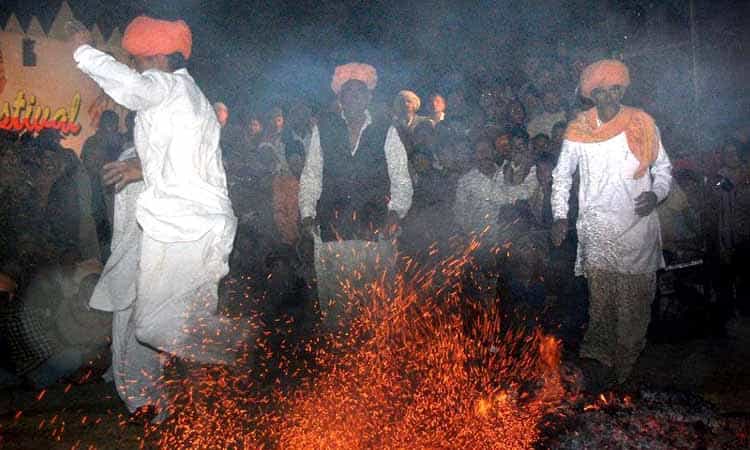
When it comes to dances in Rajasthan, the people of the deserts are not far behind. The fire dance is a unique dance that is mainly famous in the desert regions of Rajasthan. This folk dance, in a way, depicts the lifestyle of the Jasnathis of the Bikaner and Churu districts of Rajasthan. This is one of the most difficult types of dance that is performed on a large piece of ground, spread out with live burning wood and charcoal. The Jasnathi tribe’s men and boys jump into this fire along the rhythmic beats of the drums. Various enchanting fire stunts are performed by the dancer while holding fire rods in their hands. Some performers also spout fire from their mouths by filling them with Kerosene.
10. Terah Taali Dance
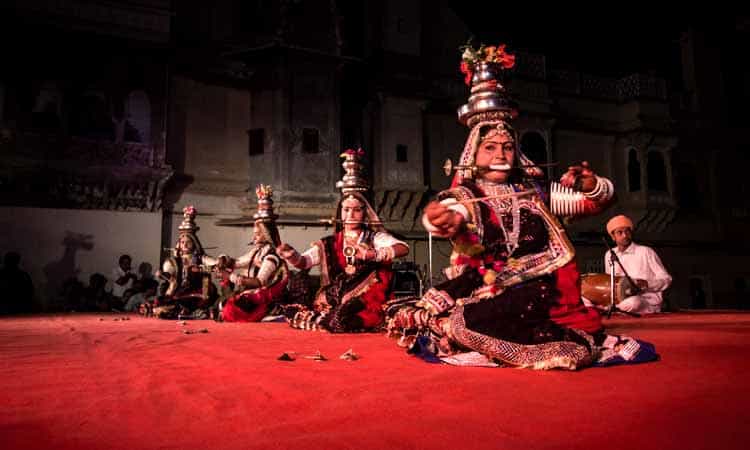
Terah Taali dance traditionally belongs to the princely states of Rajasthan and as a custom it is performed by the people of the Kamada tribes. The people of the Kamada tribes are professionally snake charmers but the dance involves a complex set of steps. Terah Taali dance is one of the complex and famous forms of traditional folk dance of Rajasthan. The Terah Taali refers to the 13 Manjeeras or little brass discs that are Tiedt to different body parts that strike against one another and work perfectly in creating a mesmerizing rhythm. Arabesques and dancing with swords in mouth is a crucial part of the dance. The way the dancers match with the swinging of the rhythmic manjeeras creates a stunning visual.
11. Drum Dance
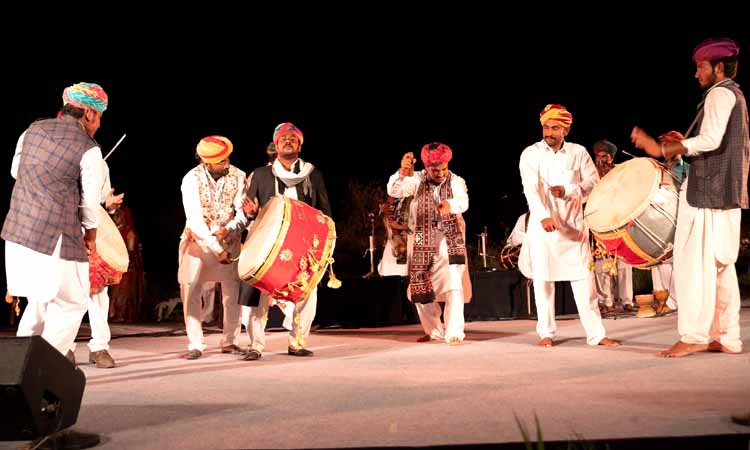
The drum dance draws its name from the beats of the drum of the dhol that is used during its performance. This traditional and professional dance form of the Jalore region is done traditionally by the men folk of the region but women can also join them during the performance. According to traditions, 5 men beat 5 large drums and Dhols that are tied around their necks. Another dancer holds large cymbals in their hands which are accompanied by enchanting drummers. Other dancers hold large naked swords in their hands which they sometimes even juggle which looks dangerous and beautiful at the same time. This has to be one of the most uniquely beautiful dances of the state that has managed to stand the test of time.
Frequently Asked Questions (FAQs)
Q. When Is The Best Time To Visit Rajasthan?
Ans. November to February is the best time to visit Rajasthan.
Q. How Is Rajasthan So Rich in Culture?
Ans. Over the years, Rajasthan has been ruled by various kings like the Rajput Rulers, Maratha Rulers, and Muslim Rulers, etc. this is why the culture in Rajasthan is so diverse.
Q. Which Are The Most Visited Places In Rajasthan?
Ans. The most visited tourist attractions in Rajasthan are Bikaner, Jaisalmer, Ajmer, Jodhpur, Alwar, etc.
Q. Which Are The UNESCO World Heritage Sites In Rajasthan?
Ans. Chittorgarh Fort, Kumbhalgarh Fort, Ranthambore Fort, Amber Fort, Gagron Fort, Keoladeo National Park, and Jantar Mantar are the UNESCO world heritage sites in Rajasthan.
Q. Why Did Rajasthan Get The Name Of A Pink City?
Ans. During the reign of Sawai Ram Singh 1, the entire city was painted pink to welcome the Prince of Wales. There are still some remnants of the pink city that can be seen in the avenues.


COMMENTS